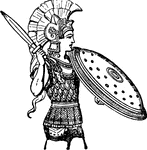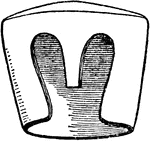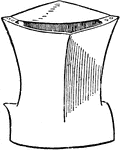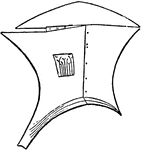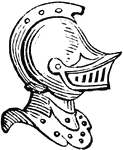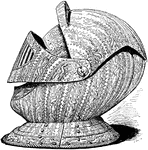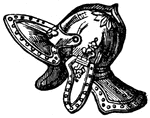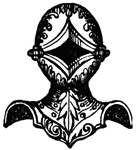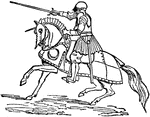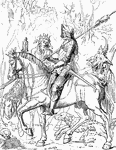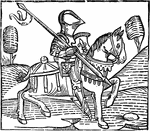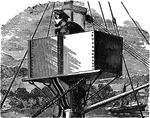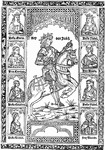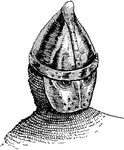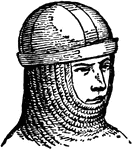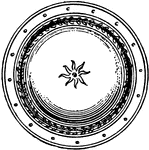
Genouillère
"Genouillère, middle of 13th century. The knee-piece, of hammered iron, introduced toward the…
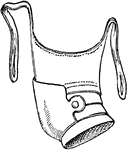
Genouillère
"Genouillère, middle of 13th century. An articulated piece forming a part of the jambe or of…

Glove-Shield
"Glove-shield, 15th century. A contrivance adopted in the sixteenth century for arming the left hand…

Glove-Shield
"Glove-shield, 15th century. A contrivance adopted in the sixteenth century for arming the left hand…
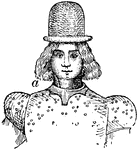
Gorget
"1, Hausse-col (a) attached to the brigandline, 15th century. GORGET. A piece of armor protecting the…
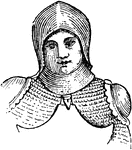
Gorget
"2, Hausse-col (a) worn over mail, early 15th century. GORGET. A piece of armor protecting the throat…

Gothic Armor
"Gothic Style of Armor. Monument of Count Otto IV of Henneberg." — The Encyclopedia Britannica,…

Greaves and shield
"Represents the interior view of a bronze shield and a pair of greaves. These greaves are made right…
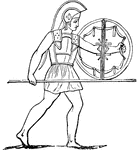
Greek with shield
"In the Homeric times, the Greeks used a belt for the sword, and another for the shield. These passed…

Hawking Glove
A glove used in the sport hawking, employed to protect ones hand and wrist from the talons and beak…
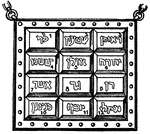
Hebrew Breastplate
This illustration shows the gems worn on the breast plate of the high priest of the Hebrews. Each of…
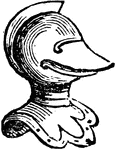
Closed Helmet Direct
"The closed helmet seen in profile is appropriated to esquires and gentlemen." -Hall, 1862
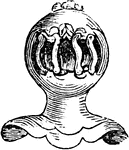
Grated Helmet Direct
"The position of the helmet is a mark of distinction. The direct front view of the grated helmet belongs…
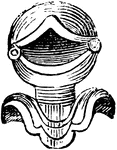
Open Helmet Direct
"The helmet without bars, with the beaver open, standing directly fronting the spectator, denotes a…
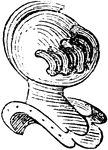
Grated Helmet Profile
"The grated helmet in profile is common to all degrees of peerage under a duke." -Hall, 1862

Medieval Helmet with Fan Crest
"Fan-crest, about 1350. A form of crest common in the middle ages at different periods, as in the reign…

Crested helmets
""The crested Achilles was pressing on in his chariot." Some idea of the ancient crests may be formed…
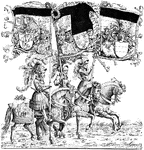
Horsemen, Three Abreast, with Banners
Horsemen, Three Abreast, with Banners, from the engraving 'The Triumphal Procession' by Hans Burgkmair.

Iron Skullcaps from the 16th Century
Two skullcaps used for defense of the head in the 16th century. The caps fit closely to the head. The…
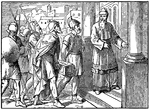
Judas Sends Twelve Thousand Drachmas of Silver to Jerusalem
"And when he had made a gathering throughout the company to the sum of two thousand drachms of silver,…
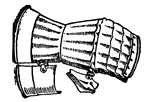
Mitten (Armor)
The 'mitten' superseded the gauntlet of the 14th century. Rather than having separate, unjointed fingers,…

A United States protected Cruiser at Sea
Protected cruisers were a type of naval cruiser of the late 19th century, so known because their deck…

Quatrefoil
"The quatrefoil is four-leaved grass; a frequent bearing in coat-armor."—(Charles Leonard-Stuart,…
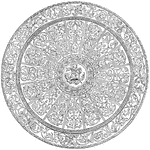
Shield
This shield is made out of iron. It is cut in fanciful technique and inlaid with gold and silver.

Kite Shield
A Norman kite shield of the 10th or 11th century, considered the beginning of the High Middle Ages.
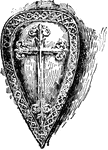
Medieval Shield
A shield of mounted men-at-arms from the first half of the 13th century, considered the High Middle…
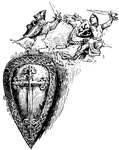
Medieval Shields from the 13th and 14th Centuries
Illustration including one large shield from the first half of the 13th century, bearing a decorative…

Greek soldier
"The early Greeks used a very short sword, as may be seen from the preceding cut. The ancient Homeric…


